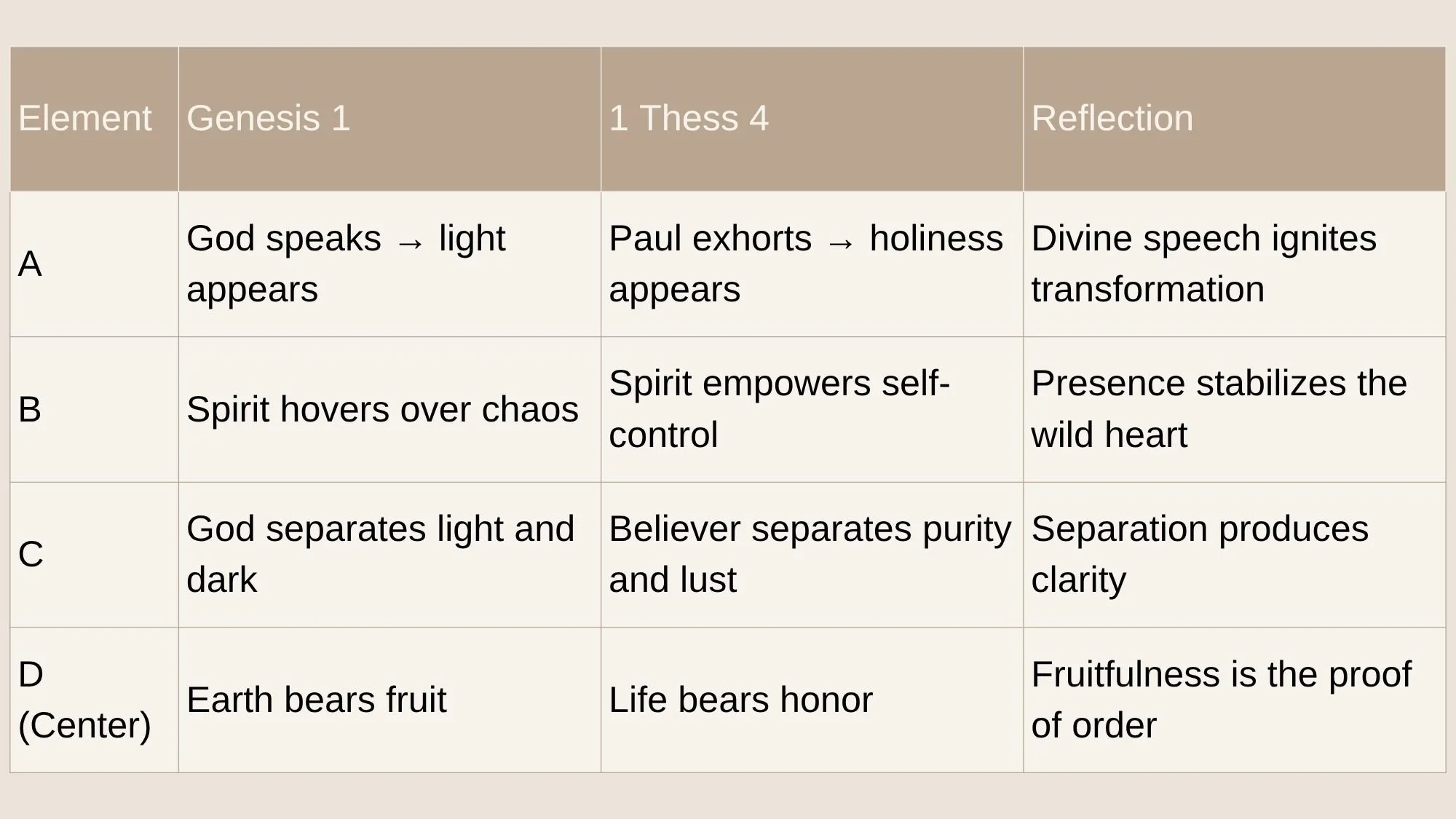From Chaos to Character — Living in the Order of God
New Testament
1 Thessalonians 4:1-7
Live to Please God
4 Finally, dear brothers and sisters, we urge you in the name of the Lord Jesus to live in a way that pleases God, as we have taught you. You live this way already, and we encourage you to do so even more. 2 For you remember what we taught you by the authority of the Lord Jesus.
3 God’s will is for you to be holy, so stay away from all sexual sin. 4 Then each of you will control his own body and live in holiness and honor— 5 not in lustful passion like the pagans who do not know God and his ways. 6 Never harm or cheat a fellow believer in this matter by violating his wife, for the Lord avenges all such sins, as we have solemnly warned you before. 7 God has called us to live holy lives, not impure lives.
Old Testament
Bereshit (Genesis) Chapter 1
1 In the beginning of God’s creation of heaven and earth—
2 when the earth was astonishingly void, with darkness over the surface of the abyss, i.e., the water, and God’s spirit hovered over the surface of the water—
3 God said, “Let there be light,” and there was light.
4 God saw that the light was good, so God separated between the light and the darkness.
5 God called to the light and assigned it to the day, and He called to the darkness and assigned it to the night. Thus, there was first nightfall followed by the rest of the night, and then morning followed by the rest of the day, together constituting one full day.
6 God said, “Let there be a sky in the midst of the water, and it will separate between atmospheric water and ocean water.”
7 So God positioned the sky, and thus separated the water below the sky from the water above the sky. And so it was.
8 God called the sky “Heaven.” There was nightfall followed by the rest of the night, and morning followed by the rest of the day, together constituting a second day.
9 God said, “Let the water below the heaven be gathered to one place, the oceans, so dry land should be seen,” and so it was.
10 God called the dry land “Earth,” and He called the gathering of water “Seas.” God saw that it was good.
11 God said, “Let the earth begin to sprout vegetation underground: seed-bearing plants and trees whose bark tastes the same as its fruit that produce fruits with seeds according to their species, on the earth.” And so it was.
12 The earth gave forth vegetation: plants bearing seeds according to their species, trees whose bark did not taste the same as their fruit, only producing fruits containing seeds according to their species. God saw that it was good.
13 There was nightfall followed by the rest of the night, and morning followed by the rest of the day, together constituting a third day.
14 God said, “Let there be luminaries in the sky to separate between day and night. They will serve as signs, for setting the dates of the Jewish festivals, and for reckoning days and years.
15 They will also serve as luminaries in the sky, to shine on the earth.” And so it was, as follows:
16 God positioned the two great luminaries, the sun and the moon. God assigned the greater light—the sun—to rule the day, and the smaller light—the moon—to rule the night, accompanied by the stars and planets.
17 God placed them in the sky to shine on the earth,
18 to rule by day and by night, and to separate between the light and the darkness. God saw that it was good.
19 There was nightfall followed by the rest of the night, and morning followed by the rest of the day, together constituting a fourth day.
Chiastic Structure: Order within the Chaos
Fruitfulness is the proof of order
Chiastic Center: Fruit and honor both emerge where boundaries are respected.
PARDES Reflection
Peshat (Literal)
God orders the visible world; Paul orders the moral life. Both are divine architecture.
Remez (Hint)
The hidden light before the sun mirrors the hidden holiness before behavior. God works in the unseen first.
Drash (Interpretive)
Separation in creation teaches discernment in living. The line between holy and common keeps the world safe.
Sod (Mystical)
Each act of obedience mirrors the Sefirot—divine attributes flowing into form. To be holy is to echo God’s inner order.
Word Studies
Bereshit (בְּרֵאשִׁית) – “In the beginning”
Not a point in time, but a process of initiation. The prefix be- means “within”—as in within the beginning itself. The sages teach: “God looked into the Torah and created the world.” Thus, Genesis 1 is not just history; it is the pattern of how God still creates within us—through structure, word, and Spirit.
Tohu va-vohu (תֹהוּ וָבֹהוּ) – “Formless and void”
In rabbinic interpretation (Rashi, Ramban), this phrase describes not evil, but potential. Chaos is pregnant with purpose. The Spirit (Ruach Elohim) hovers—literally “flutters” (merachefet) like a bird brooding over her eggs—waiting to birth life.
Ruach Elohim (רוּחַ אֱלֹהִים) – “Spirit of God”
Targum Onkelos renders this as “a wind from before the Lord.”
The Zohar expands: “This is the Spirit of the Messiah.” Thus from the first verse, God’s Spirit, Word, and Light are intertwined. (Compare John 1:1–5; 2 Corinthians 4:6)
Yehi or (יְהִי אוֹר) – “Let there be light”
The light here precedes the sun; the rabbis call it Or Ganuz, “the hidden light,” concealed for the righteous in the world to come (Chagigah 12a).
In homiletic form: this is revelation light—the same that awakens conscience and purpose.

